Yves here. John Helmer provide another insightful post on the Russian campaign against Ukraine’s electric grid, today providing more information of the logic of the targeting and how it is intended to advance Russian strategic aims.
One big quibble is where Helmer quotes a North American expert on military infrastructure expert who makes statements that go way beyond his expertise. He opines that the Russians are working against a November 15 timetable so that Putin can talk to Biden and Zelensky at the G20.
Huh? First, Putin hasn’t even decided if he is going. Second, Russia knows the West is not agreement capable so there isn’t any point in talking until perhaps Ukraine is allowed to sue for peace (I don’t see how that happens because the West is better served by maintaining that Russia is an illegitimate victor, but Nassim Nicholas Taleb reminds us that tails are fat). Russia-West relations are so bad that TASS reported that Foreign Minister Sergey Lavrov recommended cutting back on diplomatic missions in the US/EU regions:
It makes no sense to maintain the former diplomatic presence in Western countries; Russian diplomats work there in conditions that can hardly be called human. This was stated on Tuesday by Russian Foreign Minister Sergei Lavrov at a meeting with university graduates who were first accepted into the diplomatic service.
“It makes no sense and desire to maintain the same presence in Western countries. Our people work in conditions that can hardly be called human. They are created constant problems, threats of physical attacks. any economic cooperation. You won’t be forced to be nice,” Lavrov said.
Biden has also said Putin must ask for any talk at the G20 but Ukraine is off limits, and Biden is willing to entertain (only) topics that he’s made obvious are of keen interest to him, like the release of Britney Griner. BTW bringing up Griner again is another diss, since the Russian Foreign Ministry said it isn’t prepared to talk about her at high levels or in public; this sort of prisoner swap is to be handled through channels.
Finally, if Putin were to negotiate any time soon, even assuming a Damascene conversion all across the West, he’d face an internal and popular revolt at home. Ironically, the path to regime change in Russia would be to attempt to end the war.
However, some Russian commentators have said Ukraine has been told it needs to take Kherson by November 15. That’s been taken to mean Biden wants to be able to claim a big win by the midterms, or at worst the G20. General Surovikin explained how the most likely way Ukraine will act against Kherson is not a military campaign but a large scale terrorist attack, like blowing the dam at the Kakhovskaya hydroelectric power station to flood the city.
By John Helmer who has been the longest continuously serving foreign correspondent in Russia, and the only western journalist to have directed his own bureau independent of single national or commercial ties. Helmer has also been a professor of political science, and advisor to government heads in Greece, the United States, and Asia. Originally published at Dances with Bears
In war, force and money do the talking on the ground. Not talk in the air.
On the electric battlefield in the Ukraine, the targeting of Russian attacks is being calculated to cut the command and control links between the Galician capitals of Lvov and Kiev west of the Dnieper River and the Russian east, according to fresh analyses prepared by a North American military specialist in infrastructure demolition.
In the first round this month, he says, the missile raids were a “reconnaissance in force. The Russians were experimenting with, and proving, their operational concepts; for instance, how well Iranian drones perform in concert with their other weapons options and tactics. They were testing NATO counter- measures as well.”
For the time being, this is allowing the wealthy quarters of both cities to enjoy plentiful electricity; even rising house prices according to Kiev realtors in interviews to European media. They are the sources for western media reporting of how normal and resilient the two cities are.
However, the BBC is now reporting President Vladimir Zelensky as saying “that 30% of Ukraine’s power stations had been destroyed in the past eight days. Parts of the capital Kyiv have no power and water after new strikes on Tuesday.” The state propaganda organ added: “UK defence intelligence said it was highly likely that Russia had become increasingly willing to strike civilian infrastructure, in addition to military targets, since its setbacks on the battlefield.”
The North American military source has a different assessment. “The power losses in those cities have been targeted to pit those without the money or means for relief against those who have it. The Russian General Staff goal, in my estimation, is not to break the Ukrainian population’s will to fight, or their western backers’ stream of cash and arms. It’s quite the opposite, in fact. The Russians are even allowing the electric trains to keep moving between Lvov and Poland carrying western reporters, rotating NATO staffs, and military resupplies. It’s to concentrate the new US arms supplies where they can be attacked more cost-effectively in the east; to prevent Zelensky’s men from communicating with their units and with the civilians across the Dnieper, in Kharkov and Odessa; and to allow those who want to leave to head for Poland and Germany. The Russian general who defeated Napoleon once called that his ‘Golden Bridge’ strategy.”
He is referring to Marshal Mikhail Kutuzov (lead image, left). The deadline in the Russian calculation is November 15, when President Joseph Biden (centre) will meet President Vladimir Putin (right) at the G20 summit in Bali, Indonesia, along with a Ukrainian delegation headed by Zelensky. “A quick glance at Ukrainian rail ticket sites shows that the trains are still running between Kiev and Lvov. I don’t believe this is an accident, nor a failure, of the Russian side. With the escalation this week, I believe we are in the attrition phase of the Electric War which coincides with the Ukrainian electricity market data releases, and the approaching Indonesia meeting.”
Zelensky, the BBC and the British Ministry of Defence were lying about the dates and fudging the damage disclosure.
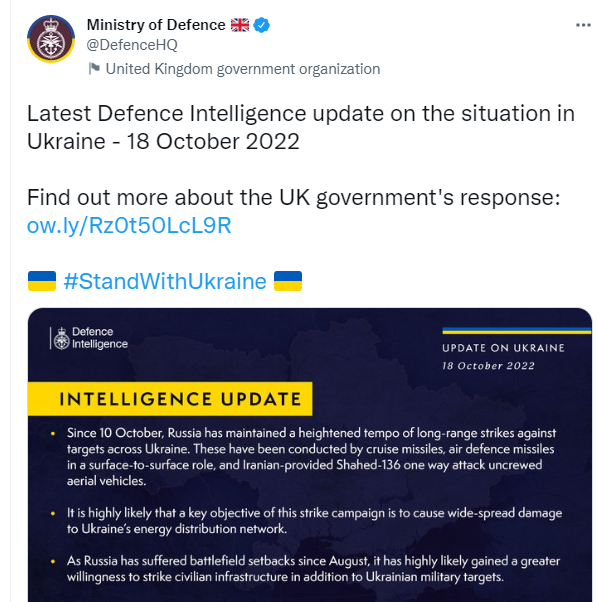
MoD tweet, source: https://twitter.com/
On October 13, following the first round of Russian attacks, the Ukrainian oligarch-owned DTEK utility published a notice for its customers, revealing: “In two days [October 10-12], Russian missiles damaged about 30% of Ukraine’s energy infrastructure. Before the start of the heating season, the occupiers cynically hit the CHP [combined heat and power plant system], substations and networks, trying to sow panic and plunge the country into a total blackout. Power engineers are working 24/7 to eliminate large-scale destruction that no European country has known so far. To balance the power system, NPC Ukrenergo had to take steps which were talked about in the summer — the introduction of an emergency power outage schedule.”
“These measures are not [sic] associated with a shortage of resources. Ukrenergo reports that Ukraine does not yet need electricity imports, although such a possibility technically exists and is being considered. The restriction of supply is necessary, first of all, to complete the restoration work, reduce the load on the power system and regulate capacity. To this end, the government called on the population and business to reduce electricity consumption during the peak period from 17:00 to 22:00. Ukrainians responded to the authorities’ request — on October 10, in the evening, electricity consumption in the country decreased by 10%, and separately in the Kyiv region this figure was 26.5%. However, this is largely due to the outages that began on the same day in the capital and the region.”
“When to prepare to turn off your home? By order of Ukrenergo, distribution system operators promptly drew up hourly schedules for power outages and informed their customers about this. For Kyiv residents, they are posted on the DTEK Kyiv Grids website. However, unlike peacetime, the current situation changes every hour and makes its own adjustments to the observance of plans.”
“For example, now the average daily consumption in the capital is 1000 MWh, and during peak loads – 1100-1300 MWh. To balance the power system in the face of an infrastructure shortage, Ukrenergo can at any time instruct the distribution system operator to reduce the load. Instead, the distribution system operator must urgently limit the power supply to consumers, guided by a number of factors — the criticality of objects, their total consumption and load on the network, technical features of connection, etc. To maintain the stability of the power system, this process must occur in a matter of minutes. In addition, at the request of Ukrenergo, a more massive and prolonged supply restriction may be required than planned.
“That is why real-time changes occur in the basic shutdown schedules, and given the special mode of power system control, you need to treat this with understanding. For the first time, Ukraine faced energy terror and now all structures are working in an enhanced mode to eliminate the consequences as soon as possible. The energy front needs the support of everyone The tense situation in the energy sector requires decisive action on the part of all enterprises in the industry. But despite the tremendous efforts that energy workers are now making, the responsibility also remains with all consumers. Today, more than ever before, the wise use of resources is important. Changing everyday habits should be transformed into a culture of rational consumption. Therefore, it will enable Ukraine to stay with the light and survive the most difficult heating season since independence.”
Two days later, on October 15, DTEK acknowledged the supply situation had become more critical. “Due to the damage, caused by rf’s [without caps Russian Federation] shelling of energy infrastructure facilities, state power company NPC Ukrenergo warns about possible stabilization power cutoffs. They will be applied only in the event of an imbalance in the energy system and upon an NPC Ukrenergo order. In order for the residents of the Kyiv region to be prepared in advance, DTEK Kyiv Regional Grids posts an indicative list of settlements, where power supply will be limited, if required. An indicative list of settlements, where power supply may be missing, is available via DTEK Kyiv Regional Grids website and social networks. Temporary stabilization cutoffs may begin in the evening after NPC Ukrenergo order and will last until the load on the energy system decreases and state power company stabilizes the energy system. We will inform about possible power cutoffs and resumption of electricity supply additionally via DTEK Kyiv Regional Grids website and social networks pages. In order to support the energy system we urge all residents of the Kyiv region to minimize electricity consumption – not to switch on energy-consuming devices and reduce electricity consumption as much as possible in the evening from 18.00 to 23.00. We urge business customers to limit usage of exterior lighting of facades of offices, restaurants, malls, etc.”
“Take care of yourself and your family! We believe in Victory!”
Consumers were less confident. They were warned by the Mayor of Lvov, Andrei Sadovy, speaking from his home in a wealthy city neighbourhood, that evacuation to Poland is unpatriotic. In Kiev, the head of the Verkhovna Rada Committee on Tax Policy Daniil Getmantsev praised Ukrainians for buying candles and firewood to help the state in such a difficult period…It is incomparably better than Kiev-Warsaw train tickets. The fire of these candles is the fire of our Victory!’”
For the time being, the Ukrainian state utility Ukrenergo and its power trading agency, Market Operator, are providing open-source daily data tables and charts revealing the real-time situation on the battlefield, not the propaganda.
What the Russian tactics are doing, the North American source confirms, is to disable electricity production from coal-fired plants and cut high-voltage transmission lines at the sub-stations and running between them. The impact is to cause severe, volatile, and constant imbalances between state supply and public demand; they show as spikes on the demand and the electricity price charts.
MAP OF UKRAINIAN HIGH-VOLTAGE 33O kV TRANSMISSION LINES
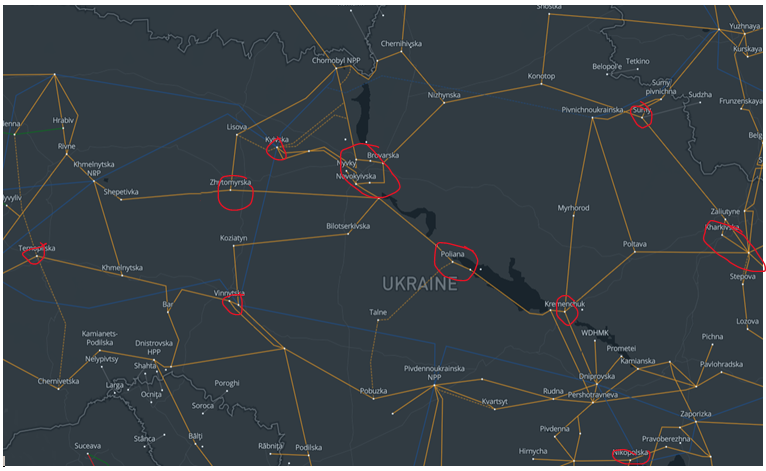
Only the Ukraine, the Baltic states, and Russia operate 330kV transmission lines This is making it increasingly difficult to replace the damage.
Source: https://www.entsoe.eu/data/map/
ELECTRICITY GENERATION IN THE UKRAINE, BY SOURCE, DATE AND HOUR – UKRENERGO CHART TO OCTOBER 19
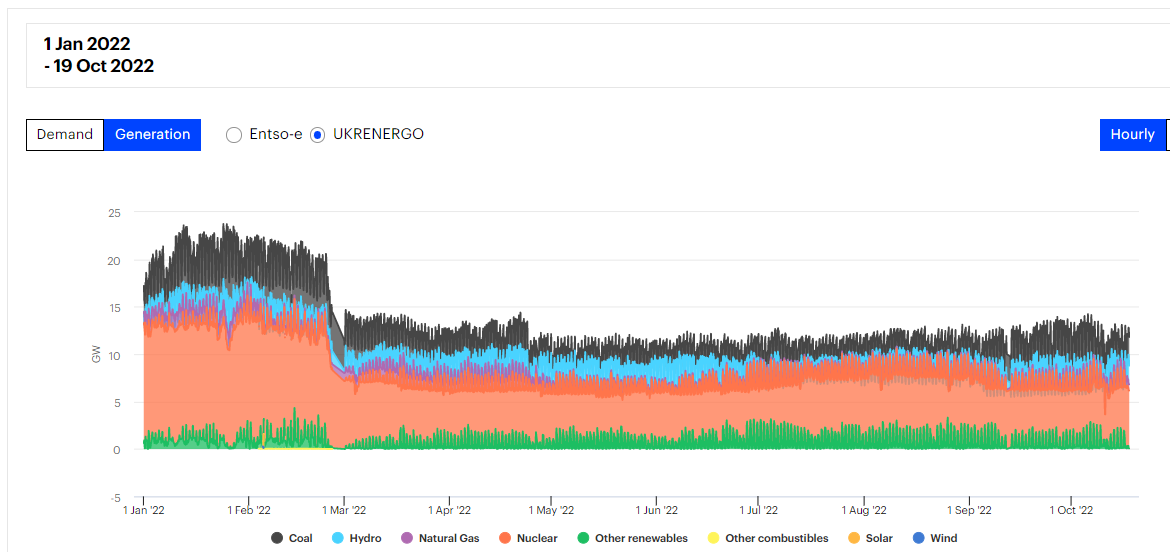
Click on source for enlarged view and data points for each source of power generation: https://www.iea.org/
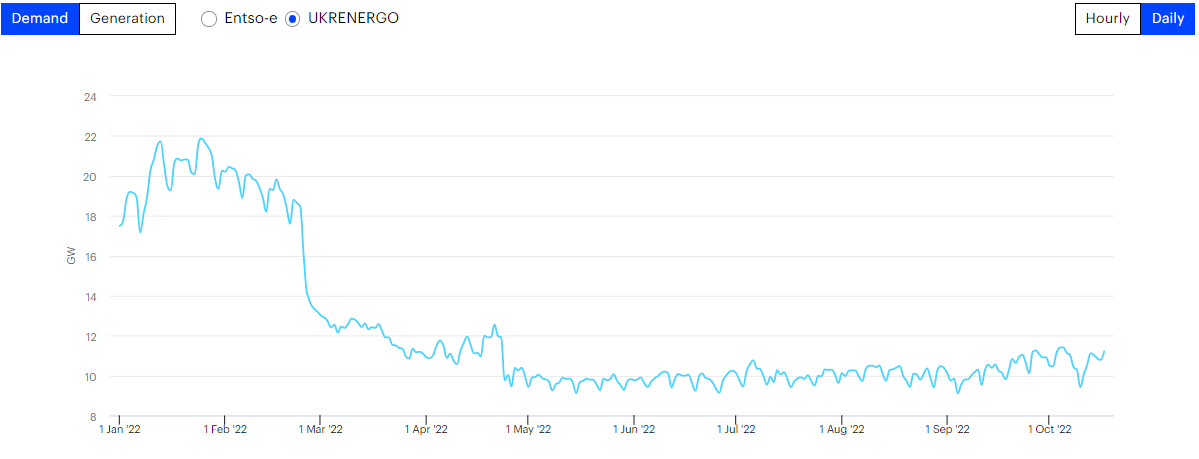
Click on source for enlarged view and data points: https://www.iea.org/
PRICE IMPACTS ON UKRAINIAN ELECTRICITY MARKET FOR THE MONTH OF OCTOBER
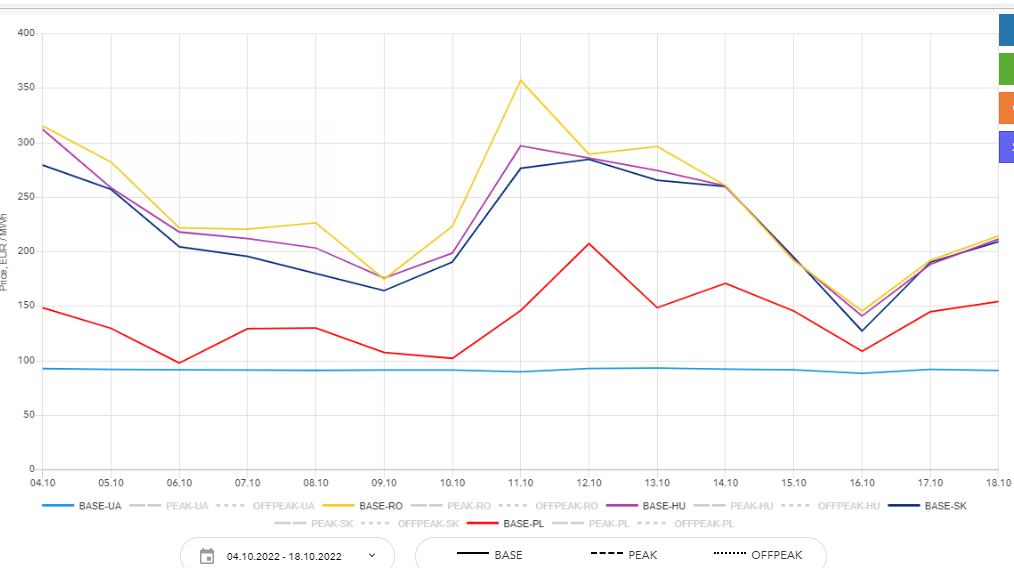
For enlargement and definition of data lines, click on source: https://www.oree.com.ua/index.php/IDM_graphs
PRICE IMPACTS ON THE UKRAINIAN DAY-AHEAD MARKET (DAM) DURING THE OCTOBER 16-17 RAIDS
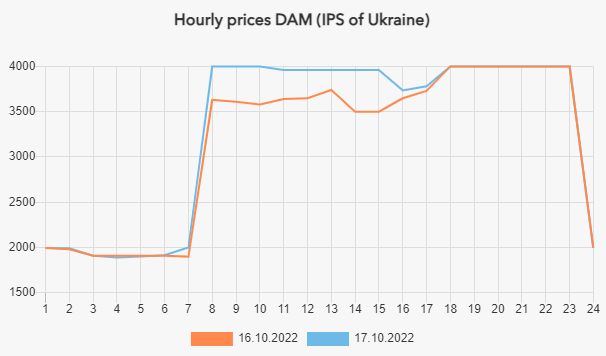
Market Operator is a Ukrainian state enterprise, established in mid-2019 and then converted to a state stockholding company which cannot be privatized. Its role is to organize the sale and purchase of electricity on the Day-Ahead Market and the Intraday Market, and thereby balance demand and supply. “On the Day-Ahead Market (DAM), electricity is sold and bought on the next day after the auction. A price on this segment of the market is determined by the marginal pricing principle, with an aim of minimizing price and maximizing trading volumes. None of the DAM participants see the offered prices and volumes of buying / selling of electricity by other participants. This technology is described by Market Operator as promoting competition of bidding on DAM. On the Intraday Market (IDM), electricity is sold and bought continuously after day-ahead auctions and during the physical supply of electricity. This market segment enables market participants to adjust their trading positions and works on the principle that ‘each product has its own buyer’. That is, sellers and buyers declare the volumes and prices at which they want to sell / buy electricity, and they then wait for a counterparty.” Source: https://www.oree.com.ua/
By sustaining the attacks with low-cost drones, the North American source comments, “it is unlikely that the Ukrainian utility crews, certainly exhausted now and terrified from working around the clock to effect repairs, using what must be dwindling stocks of spares, will be able to keep up. Where will Ukrainian utilities like DTEK, find in-time spares for 330kV gear that is unique to Russia and the CIS countries? Furthermore, will 1000MVA, 750kV-330kV autotransformers, with all their required metering, control and protection relays, breakers, etc., fall out of the sky like the Russian, Iranian, or Turkish drones do? The answers to those questions are nowhere and no.”
“We can anticipate that the strongest attacks, in terms of concentration, accuracy and impact, will occur with lower temperatures. Now, with winter just weeks, if not days, away, inclement weather including high winds, heavy, wet snow — all famous for knocking down power lines — will only compound the problems for the Ukrainians.”
“Who can doubt that the Russians will coordinate their strikes with the poor weather, using it as a force multiplier? Just like old Kutuzov did the French.”


